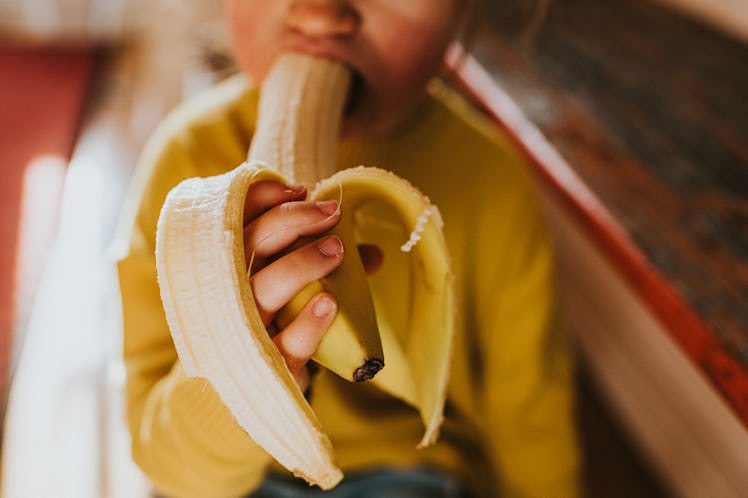Does The BRAT Diet Really Fix Upset Stomachs?
Eating bland foods like bananas, rice, applesauce, and toast can help stop a nausea rollercoaster, but it should only be used temporarily, experts say.

Vomiting and diarrhea happen — for toddlers, more often than any of us would care to to admit. So when they do have a stomach bug and are feeling bad, a quick recovery is the obvious goal. For years, pediatricians have recommended the BRAT diet — a regimen of bananas, rice, applesauce, and toast — to calm stomachs after bouts of vomiting or diarrhea. But recently, the American Academy of Pediatrics has stopped recommending the BRAT diet for kids, and the Centers for Disease Control and Prevention has warned that long-term consumption of such a restrictive diet can lead to malnutrition. But the combination of these four food items and related bland foods won’t be harmful in the short term — and is a good way to help kids ramp back up to their regular diet after dealing with an upset stomach.
What’s the BRAT Diet, And How Does It Work?
Despite the long history of the BRAT diet, no substantial clinical studies have tested how effective eating only bananas, rice, applesauce, and toast is at calming the stomach. But experts say that the strength of the BRAT diet lies in its blandness. Bananas, rice, applesauce, and toast are typically all gentle on a recovering GI tract.
Eating these foods helps get solids back into the system after symptoms start to improve, says Adam Cohen, a clinical dietician at Children’s Wisconsin Hospital in Milwaukee. “Typically, this is an especially great remedy for diarrhea,” he says of the diet. “Once stomachs start to settle, all those types of foods help solidify stool.” Foods like plain unbuttered toast are also easy to get down after vomiting, and they help an empty stomach feel full and calm after a nausea rollercoaster, he says.
Some experts have raised concerns about the plan because the four starring foods don’t provide the full suite of nutrients growing kids need day to day. That said, you don’t have to take the B, R, A, and T literally, Cohen says. The four foods that make up the BRAT diet’s name should be considered guidance for other types of foods that are similarly inoffensive to a recovering stomach. Plain crackers, oatmeal (without any fixings), plain noodles, and boiled carrots and potatoes can all help a stomach ease back into normal meals.
And of course, the BRAT diet should only be used as a short-term solution, good for getting something into your child’s stomach but not necessary to stick to if kids continue to recover. After a day or two of improving health, parents should ramp their child back up to a standard balanced diet.
How to Follow the BRAT Diet
First things first: Let the vomiting subside, Cohen says. Wait several hours before trying to get your child to stomach anything, then start with sips of clear liquids. “What we’re worried about most in these cases is dehydration,” he explains. Getting fluids back in the system is priority number one. Water is always a good choice, Cohen says, or low-sugar electrolyte drinks like Pedialyte are great options. “One thing I love to recommend is chicken broth,” he adds.
After several hours of clear fluids, you can start implementing plain, BRAT-and-adjacent foods. For example, “every few hours you can try tiny nibbles of toast,” Cohen says, making sure to skip the butter and keep tabs on symptoms as you go. Next, try applesauce or plain noodles, and then you can even give chicken noodle soup a try. Keep up the clear liquids throughout.
Avoid foods high in fats and sugars, caffeine, citrus fruits, greasy meats, and dairy products. “Parents are often concerned about their child missing milk,” Cohen says. But it can be rough on the tummy, and a couple days without it “isn’t the end of the world.”
Once your child has progressed through about a day of bland and BRAT foods, you can slowly start adding normal diet items back into rotation. Try a plain sandwich with low-fat lunch meat (skip the cheese and high-sugar condiments like ketchup), or soft-boiled eggs and soft fruits and vegetables. Within two days of the last instance of vomiting or diarrhea, your kid should be back to eating a normal diet.
Most importantly, keep tabs on how your kid is feeling, Cohen says. Like every other parent, he knows that most kids will let you know loud and clear if they’re starting to feel ill again. If this happens, take a step back to bland foods. But if they say they’re ready for more food, go ahead and follow their lead, he says. “Just take it nice and slow.”
This article was originally published on